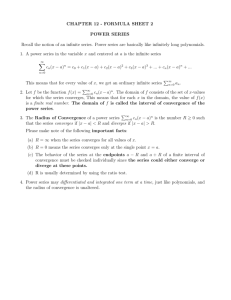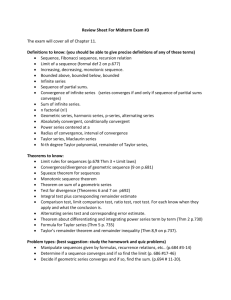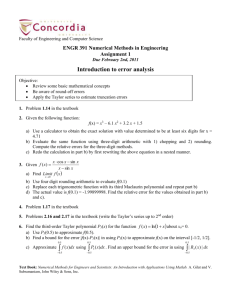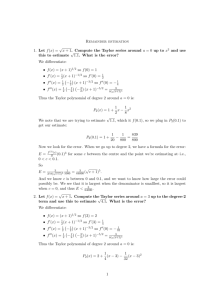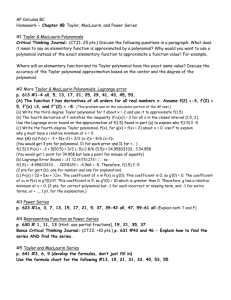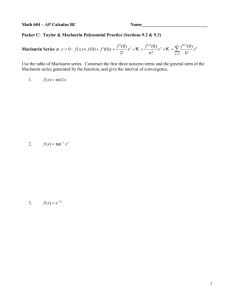Power Series, Taylor's Theorem, and Taplor
advertisement
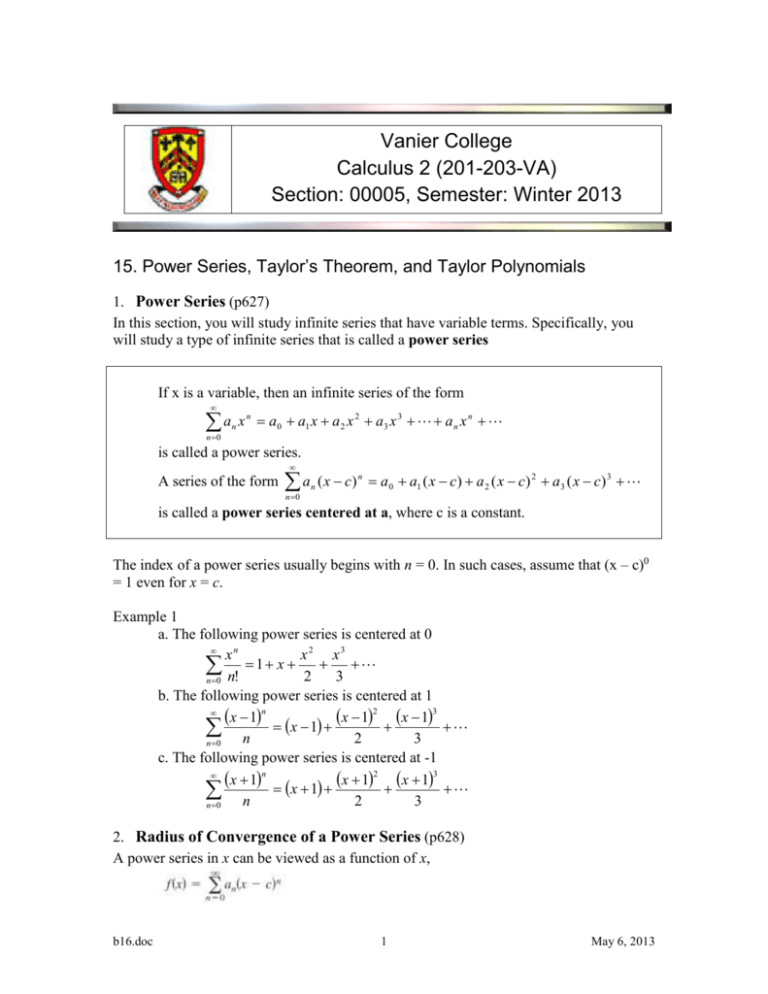
Vanier College Calculus 2 (201-203-VA) Section: 00005, Semester: Winter 2013 15. Power Series, Taylor’s Theorem, and Taylor Polynomials 1. Power Series (p627) In this section, you will study infinite series that have variable terms. Specifically, you will study a type of infinite series that is called a power series If x is a variable, then an infinite series of the form a n 0 n x n a 0 a1 x a 2 x 2 a3 x 3 a n x n is called a power series. A series of the form a n 0 n ( x c) n a 0 a1 ( x c) a 2 ( x c) 2 a3 ( x c) 3 is called a power series centered at a, where c is a constant. The index of a power series usually begins with n = 0. In such cases, assume that (x – c)0 = 1 even for x = c. Example 1 a. The following power series is centered at 0 xn x2 x3 1 x 2 3 n 0 n! b. The following power series is centered at 1 x 1n x 1 x 12 x 13 n 2 3 n 0 c. The following power series is centered at -1 x 1n x 1 x 12 x 13 n 2 3 n 0 2. Radius of Convergence of a Power Series (p628) A power series in x can be viewed as a function of x, b16.doc 1 May 6, 2013 where the domain of f is the set of all x for which the power series converges. Determining this domain is one of the primary problems associated with power series. Of course, every power series converges at its center c because So, c is always in the domain of f. In fact, the domain of a power series can take three basic forms: a single point, an interval centered at c, or the entire real number line, as shown in Figure 10.4. Convergence of a power series For a power series centered at c, a n ( x c) n one of the following is true n 0 (1) (2) The series converges only at c. There exists a positive number R such that the series converges for converges for | x – c | < R and diverges | x – c | > R (3) The series converges for all x The number R is the radius of convergence of the power series. If the series converges only at c, then R = 0, and if the series converges for all x, then R = ∞ In the second case, the series converges in the interval (c – R, c + R) and diverges in the intervals (-, c – R) and (c + R, ). Determining the convergence or divergence at the endpoints can be difficult, and, except for simple cases, the endpoint question is left open. Example 2 (p629) Find the radius of convergence of the power series. n 0 b16.doc 2 xn n! May 6, 2013 Example 3 (p629) Find the radius of convergence of the power series. 1n x 1n n 0 2n 3. Taylor and Maclaurin Series: (p630) The problem of finding a power series for a given function is answered by Taylor’s Theorem. This theorem shows how to use derivatives of a function f to write the power series for f. f n c f (c) f (c) x c 2 f (c) ( x c) 3 is called ( x c ) n f (c ) ( x c) n! 1! 2! 3! n 0 the Taylor series of f(x) centered at c . f n 0 n f (0) f (0) 2 f (0) 3 x ( x) f (0) ( x) ( x) is The Taylor series n! 1! 2! 3! n 0 called the Maclaurin series of the function. Note: We define that 0! = 1 and f (0) = f(x). Example 4 (p630) Find the power series f(x) = ex, centered at 0. What is the radius of convergence of the series? Ans. From Example 2, you know that the radius of convergence is R = b16.doc 3 May 6, 2013 In other words, the series converges for all values of x. Example 5(p631) Find the power series f(x) = 1/x, centered at 10. Then use the result to evaluate f(1/2). Ans. To evaluate the series when x = 1/2 use the formula for the sum of a geometric series. =2 In Example 5, the radius of convergence of the series is R = 1, and its interval of convergence is (0, 2). (It is possible to show that the series diverges when x = 0 and when x = 2.) Figure 10.6 compares the graph of f(x) = 1/x and the graph of the Taylor series for f. In the figure, note that the domains are different. In other words, the power series in Example 5 represents f only in the interval (0, 2). Example 6(p632) Find the Maclaurin series for each function b16.doc (1) f ( x) e x (2) f ( x) e x 2 2 4 May 6, 2013 4. Basic List of Power Series (p633) The most practical use of Taylor’s Theorem is in developing power series for a basic list of common functions. Then, from the basic list, you can determine power series for other functions by the operations of addition, subtraction, multiplication, division, differentiation, integration, and composition with known power series. sin x x x3 x5 x7 x 2 n1 (1) n 3! 5! 7! (2n 1)! n 0 x2 x4 x6 x 2n (1) n 2! 4! 6! (2n)! n 0 3 5 7 x x x x 2 n1 tan 1 x x (1) n 3 5 7 2n 1 n 0 x 2 x3 1 ex 1 x xn 2! 3! n 0 n! 2 3 4 x x x n 1 1 n ln( 1 x) x 1 x 2 3 4 n n 1 1 1 x x2 x3 xn 1 x n 0 cos x 1 -∞ < x < ∞ -∞ < x < ∞ -1 ≤ x ≤1 -∞ < x < ∞ -1 < x ≤ 1 -1< x < 1 Example 8 (p634) Find the power series for each function f ( x) 1 2e x , centered at 0 f ( x) e 2 x 1 , centered at 0 f ( x) ln 2 x , centered at 1 Sol. 2x n x 1 2e 1 n 0 n! 2n x n e 2 x 1 e n! To find the power series for ln(2x) centered at 1, use the properties of logarithms 1n1 x 1n n 1 n ln 2 x ln 2 b16.doc 5 May 6, 2013 §10.5 Taylor Polynomials (p637) 1. Taylor Polynomials and Approximation (p627) You have seen that it is sometimes possible to obtain an exact power series representation of a function. For example, the function f(x) = e-x can be represented exactly by the power series The problem with using this power series is that the exactness of its representation depends on the summation of an infinite number of terms. In practice, this is not feasible, and you must be content with a finite summation that approximates the function rather than representing it exactly. For instance, consider the sequence of partial sums below. Each of these polynomial approximations of e-x is a Taylor polynomial for e–x. As n approaches infinity, the graphs of these Taylor polynomials become closer and closer approximations of the graph of f (x) = e-x. n f i c f (c) f (c) x c 2 f ( c ) ( x c ) n ( x c ) i f (c ) ( x c) i! 1! 2! n! i 0 is called the nth-degree Taylor polynomial of f at c. n S n ( x) b16.doc 6 May 6, 2013 Example 3 Use the eight-degree Taylor polynomial for e x 2 to approximate the definite 1 integral e x dx . Compare with the result from the maple software. 2 0 Sol The eight-degree Taylor polynomial for e x is x 4 x 6 x8 S 8 ( x) 1 x 2 2 6 24 Using this polynomial, you can find the approximation as shown. 2 1 e x2 dx 0 1 S 8 ( x)dx 0 x 4 x6 x8 1 x 2 dx 2 6 24 0 1 1 x3 x5 x7 x8 x 3 5 2 7 6 9 24 0 1 1 1 1 1 0.7474867725 3 10 42 216 Using Maple software, the result is 0.7468241330 So, the approximation has an error of less than 0.001 b16.doc 7 May 6, 2013
